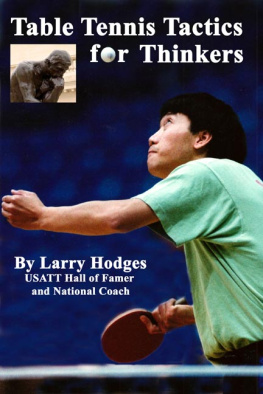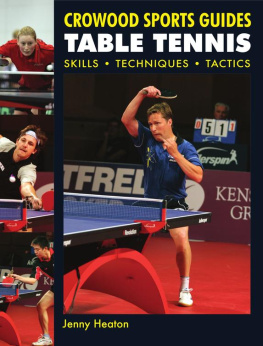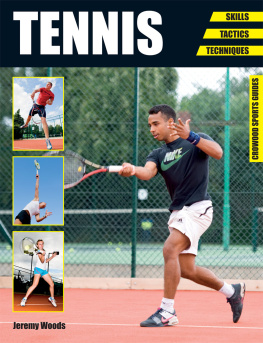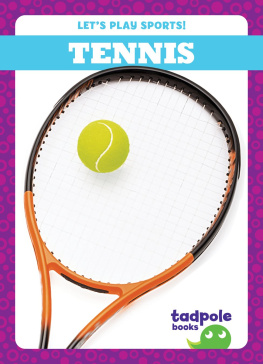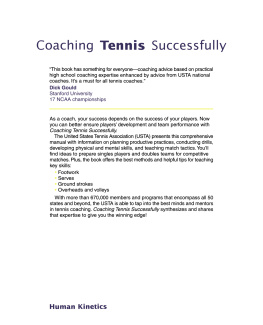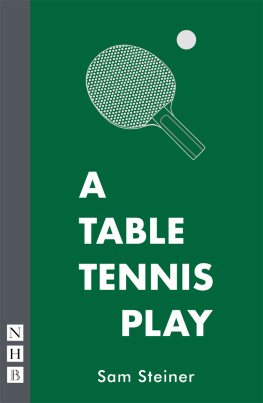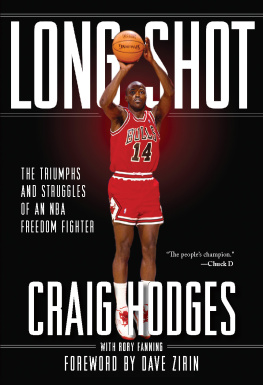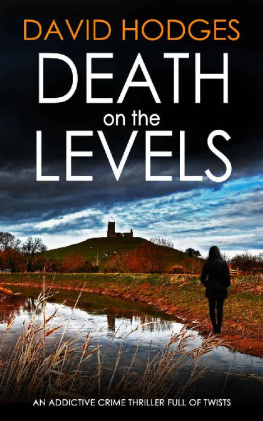Larry Hodges - Table Tennis Tactics for Thinkers
Here you can read online Larry Hodges - Table Tennis Tactics for Thinkers full text of the book (entire story) in english for free. Download pdf and epub, get meaning, cover and reviews about this ebook. year: 2013, genre: Business. Description of the work, (preface) as well as reviews are available. Best literature library LitArk.com created for fans of good reading and offers a wide selection of genres:
Romance novel
Science fiction
Adventure
Detective
Science
History
Home and family
Prose
Art
Politics
Computer
Non-fiction
Religion
Business
Children
Humor
Choose a favorite category and find really read worthwhile books. Enjoy immersion in the world of imagination, feel the emotions of the characters or learn something new for yourself, make an fascinating discovery.
- Book:Table Tennis Tactics for Thinkers
- Author:
- Genre:
- Year:2013
- Rating:5 / 5
- Favourites:Add to favourites
- Your mark:
- 100
- 1
- 2
- 3
- 4
- 5
Table Tennis Tactics for Thinkers: summary, description and annotation
We offer to read an annotation, description, summary or preface (depends on what the author of the book "Table Tennis Tactics for Thinkers" wrote himself). If you haven't found the necessary information about the book — write in the comments, we will try to find it.
Table Tennis Tactics for Thinkers — read online for free the complete book (whole text) full work
Below is the text of the book, divided by pages. System saving the place of the last page read, allows you to conveniently read the book "Table Tennis Tactics for Thinkers" online for free, without having to search again every time where you left off. Put a bookmark, and you can go to the page where you finished reading at any time.
Font size:
Interval:
Bookmark:
Table Tennis Tactics
for Thinkers
By Larry Hodges
TableTennisCoaching.com
U.S. Table Tennis Hall of Famer and National Coach
2013, v08-27-21
On the Cover :
My fellow MDTTC coach Cheng Yinghua, 2000 Olympian, 2-time U.S. Open and 4-time USA Nationals Men's Champion, and former member of the Chinese and USA National Teams.
Photo by John Oros
TABLE OF CONTENTS
INTRODUCTION
Table tennis has been called chess at lightning speed. There are hundreds of books on chess tactics. Why aren't there more books devoted to table tennis tactics?

Left: Future U.S. Table Tennis Hall of Famers John Tannehill and Dell Sweeris play chess at the 1968 U.S. Open. Photo by Mal Anderson. Right: Chess player Bobby Fischer
The purpose of this book isn't to just tell you how to play tactically against various styles, though we'll do that, but to get you thinking both tactically and strategically. What's the difference? I'll go over that. The goal is to make the most out of whatever table tennis skills you have so you can be world champion, beat the guy next door, or somewhere in between.
This book is for anyone who wants to make the most of his game, especially those who like to think. It is for all ages and levels, including:
- Beginners , who should focus on developing their game strategically so they can later have the tactical weapons needed to win;
- Intermediate players , who can execute many of the shots the best players do, and need to find ways to both maximize their tactical performance with the tools they have, and to strategically develop new weapons;
- Advanced players , who can use this book to developor further developthe habit of thinking tactically and strategically so as to maximize their performance.
There are three ways you should use this book. First and most important, read it through, and develop the habit of tactical and strategic thinking. They are your friends. (I almost called this book "Table Tennis Tactics and Strategic Development," since strategic thinking is so much a part of it.)
Second, learn and understand the general tactics that you and your playing style should use against various playing styles. When I say playing styles here, that includes not only different styles of play, but also different grips and surfaces.
Third, it's a reference for when you are trying to figure out the specific tactics needed to beat a specific player. Once you've analyzed the player in question, go to the appropriate section or sections and understand the tactical ways to overcome that player.
There's a lot to digest here, so perhaps take it in chunks. Take notes or use a highlighter. Think about how each item may affect your game. Most important, don't memorize - understand .
There are some redundancies in the book, with some techniques discussed in multiple chapters. This is unavoidable since there are overlaps between the chapters. For example, pushing short is discussed in both the chapters on Receive and on Pushing. I don't want readers to have to constantly jump around in the book, and it doesn't hurt to hear something twice.
Most of this book is new, but some of it comes from past coaching articles I've written. (And some of the Tips of the Week that I put up on TableTennisCoaching.com came from this book as I was writing it.) And speaking of table tennis past, does having twenty-one chapters bring back some table tennis nostalgia?
Want to know more about the Olympic Sport of Table Tennis? In the U.S., visit USA Table Tennis at www.usatt.org , and learn about the hundreds of tournaments, clubs, and coaches throughout the country, including my club, the Maryland Table Tennis Center, where I've been coaching since it opened in 1992. Elsewhere, visit the International Table Tennis Federation at www.ittf.com , and see their directory for other countries.
You might also want to visit my table tennis website and weekly blog, which goes up every morning, Mon-Fri, at T ableTennisCoaching.com . I started the blog in Jan., 2011. There youll also find a huge number of articles, videos, and just about anything else that has to do with table tennis. (And youll love the Fun & Games section!) You can also find info there on my other table tennis books:
- Table Tennis Tips (2014)
- More Table Tennis Tips (2017)
- Still More Table Tennis Tips (2020)
- Table Tennis Tales & Techniques (2009)
- The Spirit of Pong (2015) - fantasy table tennis novel
- Professional Table Tennis Coaches Handbook (2009, updated 2013)
- Table Tennis: Steps to Success (1993, revised 2006, 30,000+ copies sold)
- Instructors Guide to Table Tennis (1989)
I've adopted two conventions for this book. First, it is written as if the reader is right-handed. Lefties should reverse. My apologies, but this makes explaining things a lot easier. Second, I'm using "he" to describe players. I'm not going to write "he or she" and "him or her" a zillion times, nor s/he, or write everything in the plural so I can clumsily use "they" every time.
You are not expected to memorize this book, or to learn every tactical intricacy on its pages. There's something more important than that, and that is to get in the habit of thinking tactically and strategically. And so at the end of this book, in the Afterword, I will have one question for you: Did I make you think?
Glossary
Table tennis is full of colorful terms that some might not be familiar with. "Heavy no-spin"? "Half-long" and "Tweeny" serves? "Reverse Pendulum serves"? "Fishing"? "Banana" and "Strawberry" flips? Throughout this book, if you find a term you are not familiar with, go to the glossary at the back. Better still, why not browse it now, and familiarize yourself with any terms you might not know?
Editorial Board
I'd like to thank the following "Great Eight" coaches and players who reviewed, edited, proofed, and critiqued this book. Their insights and comments greatly added to the book as well as causing many long, sleepless nights as I pondered their notes.
- Scott Gordon , USATT Certified Coach and chair of the
USATT Hardbat Committee - Chris Grace
- Stephanie Hughes
- Dora Kurimay , Sports Psychologist
- Richard McAfee, USATT Coaching Chair, 2009-2013
- John Olsen , ITTF Certified Coach
- Dennis Taylor , former chair of USATT High Performance Committee
- Kevin Walton
And now it is time for you to enter into another dimension, a dimension not only of speed and spin, but of mind. A journey into a wondrous land of thought. It is a thing we call... table tennis tactics.
CHAPTER ONE
Tactical Thinking

Hopefully I'm giving good tactical advice to USA National Cadet Team Members Jonathan Ou and Tong Tong Gong at the Junior Team Competition at the 2011 USA Nationals. Photo by Bruce Liu
Tactics isn't about finding complex strategies to defeat an opponent. Tactics is about sifting through all the zillions of possible tactics and finding a few simple ones that work.
In simpler terms, the purpose of tactics is to mess up your opponent.
You do this by messing up his game, and by forcing your game on his. More specifically, tactics is finding ways to get your strengths into play while avoiding your opponent's, and going after the opponent's weaknesses while not letting him go after yours. It's figuring out how you win and lose points.
To do this, you have to know both your game and your opponent's. While you might go into a match not knowing much about your opponent (though ideally you would have scouted him out in advance), you should know all about your game. How well do you know your game?
Next pageFont size:
Interval:
Bookmark:
Similar books «Table Tennis Tactics for Thinkers»
Look at similar books to Table Tennis Tactics for Thinkers. We have selected literature similar in name and meaning in the hope of providing readers with more options to find new, interesting, not yet read works.
Discussion, reviews of the book Table Tennis Tactics for Thinkers and just readers' own opinions. Leave your comments, write what you think about the work, its meaning or the main characters. Specify what exactly you liked and what you didn't like, and why you think so.

